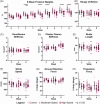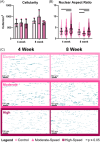Moderate- and High-Speed Treadmill Running Exercise Have Minimal Impact on Rat Achilles Tendon
- PMID: 39731286
- PMCID: PMC11806652
- DOI: 10.1002/jor.26030
Moderate- and High-Speed Treadmill Running Exercise Have Minimal Impact on Rat Achilles Tendon
Abstract
Exercise influences clinical Achilles tendon health in humans, but animal models of exercise-related Achilles tendon changes are lacking. Moreover, previous investigations of the effects of treadmill running exercise on rat Achilles tendon demonstrate variable outcomes. Our objective was to assess the functional, structural, cellular, and biomechanical impacts of treadmill running exercise on rat Achilles tendon with sensitive in and ex vivo approaches. Three running levels were assessed over the course of 8 weeks: control (cage activity), moderate-speed (treadmill running at 10 m/min, no incline), and high-speed (treadmill running at 20 m/min, 10° incline). We hypothesized that moderate-speed treadmill running would beneficially impact tendon biomechanics through increased tenocyte cellularity, metabolism, and anabolism whereas high-speed treadmill running would cause a tendinopathic phenotype with compromised tendon biomechanics due to pathologic tenocyte differentiation, metabolism, and catabolism. Contrary to our hypothesis, treadmill running exercise at these speeds had a nominal effect on the rat Achilles tendon. Treadmill running modestly influenced tenocyte metabolism and nuclear aspect ratio as well as viscoelastic tendon properties but did not cause a tendinopathic phenotype. These findings highlight the need for improved models of exercise- and loading-related tendon changes that can be leveraged to develop strategies for tendinopathy prevention and treatment.
Keywords: Achilles tendon; biomechanics; exercise; kinematics and kinetics; mechanobiology.
© 2024 The Author(s). Journal of Orthopaedic Research published by Wiley Periodicals LLC on behalf of Orthopaedic Research Society.
Figures







Similar articles
-
Sixteen weeks of high-speed treadmill running is insufficient to induce Achilles tendinopathy in a rat model.Am J Physiol Cell Physiol. 2025 Jun 1;328(6):C2013-C2022. doi: 10.1152/ajpcell.00186.2025. Epub 2025 May 8. Am J Physiol Cell Physiol. 2025. PMID: 40337916 Free PMC article.
-
Uphill running does not exacerbate collagenase-induced pathological changes in the Achilles tendon of rats selectively bred for high-capacity running.Connect Tissue Res. 2013;54(6):386-93. doi: 10.3109/03008207.2013.848201. Connect Tissue Res. 2013. PMID: 24060053
-
Enforced bipedal downhill running induces Achilles tendinosis in rats.Connect Tissue Res. 2011;52(6):466-71. doi: 10.3109/03008207.2011.562334. Epub 2011 May 18. Connect Tissue Res. 2011. PMID: 21591929
-
Uphill running improves rat Achilles tendon tissue mechanical properties and alters gene expression without inducing pathological changes.J Appl Physiol (1985). 2012 Sep 1;113(5):827-36. doi: 10.1152/japplphysiol.00401.2012. Epub 2012 Jul 12. J Appl Physiol (1985). 2012. PMID: 22797314
-
Mechanobiology of young and aging tendons: In vivo studies with treadmill running.J Orthop Res. 2018 Feb;36(2):557-565. doi: 10.1002/jor.23761. Epub 2017 Nov 22. J Orthop Res. 2018. PMID: 28976604 Free PMC article. Review.
Cited by
-
Sixteen weeks of high-speed treadmill running is insufficient to induce Achilles tendinopathy in a rat model.Am J Physiol Cell Physiol. 2025 Jun 1;328(6):C2013-C2022. doi: 10.1152/ajpcell.00186.2025. Epub 2025 May 8. Am J Physiol Cell Physiol. 2025. PMID: 40337916 Free PMC article.
References
-
- Lantto I., Heikkinen J., Flinkkilä T., Ohtonen P., and Leppilahti J., “Epidemiology of Achilles Tendon Ruptures: Increasing Incidence Over a 33‐year Period,” Scandinavian Journal of Medicine & Science in Sports 25, no. 1 (2015): e133–e138. - PubMed
-
- Longo U. G., Ronga M., and Maffulli N., “Achilles Tendinopathy,” Sports Medicine and Arthroscopy Review 26, no. 1 (2018): 16–30. - PubMed
-
- Kujala U. M., Sarna S., and Kaprio J., “Cumulative Incidence of Achilles Tendon Rupture and Tendinopathy in Male Former Elite Athletes,” Clinical Journal of Sport Medicine 15, no. 3 (2005): 133–135. - PubMed
MeSH terms
Grants and funding
- F31 AR082282/AR/NIAMS NIH HHS/United States
- P30 AR069619/AR/NIAMS NIH HHS/United States
- P50 AR080581/AR/NIAMS NIH HHS/United States
- National Institute of Arthritis and Musculoskeletal and Skin Diseases (F31AR082282), Orthopaedic Research and Education Foundation Resident Clinician Scientist Training Grant, Penn Center for Musculoskeletal Disorders (P30AR069619), and Penn Achilles Tendinopathy Center of Research Translation (P50AR080581).
LinkOut - more resources
Full Text Sources

